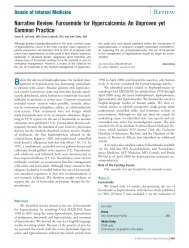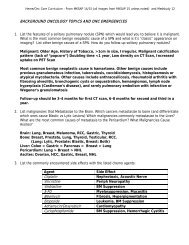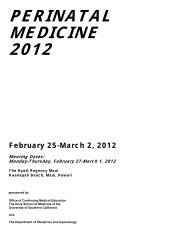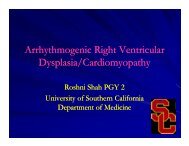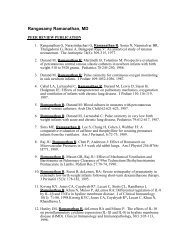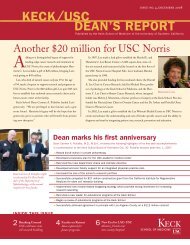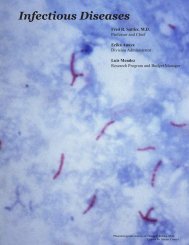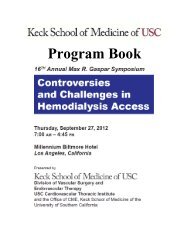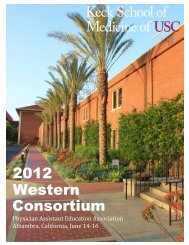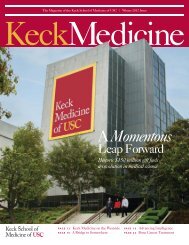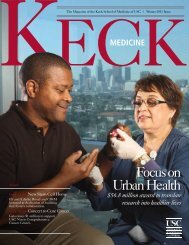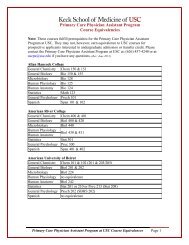USC NoRRiS - Keck School of Medicine of USC - University of ...
USC NoRRiS - Keck School of Medicine of USC - University of ...
USC NoRRiS - Keck School of Medicine of USC - University of ...
You also want an ePaper? Increase the reach of your titles
YUMPU automatically turns print PDFs into web optimized ePapers that Google loves.
Upfront News“NCI picked thismolecule becauseit is curative inmany people. If wecan reduce itstoxicity, we can helpmore patients. ”Epstein Receives National Cancer Institute AwardAlan L. Epstein, M.D., Ph.D.,member <strong>of</strong> the <strong>USC</strong> NorrisComprehensive Cancer Center,has received an award <strong>of</strong>$3.5 million from the NationalCancer Institute (NCI) fora recent advancement indrug development.Epstein’s breakthroughdiscovery is aimed at helpingpatients with metastatic melanomaand renal cell carcinoma.The reagent he developed withPeisheng Hu, Ph.D., assistantpr<strong>of</strong>essor <strong>of</strong> research pathologyat the <strong>Keck</strong> <strong>School</strong> <strong>of</strong> <strong>Medicine</strong><strong>of</strong> <strong>USC</strong>, is an analog <strong>of</strong>Interleukin-2 (IL-2), which isan important therapeuticfor cancer patients. Currenttherapy with IL-2 is limited dueto its severe toxicity and sideeffects. Epstein’s developmentwas selected by NCI due toits potential to eliminate thetoxicity <strong>of</strong> the drug.“NCI picked this mole culebecause it is curative in manypeople,” said Epstein, whois also a pr<strong>of</strong>essor in theDepartment <strong>of</strong> Pathology atthe <strong>Keck</strong> <strong>School</strong>. “If we canreduce its toxicity, we canhelp more patients.”Epstein will serve asan advisor to the NCI teamthat will do developmentwork, toxicology studiesand other tasks needed tobring the discovery frombench to bedside.Top Tier <strong>USC</strong> Norris Cancer Hospital ranked second among Los Angeles hospitalsin Consumer Reports’ new ratings <strong>of</strong> more than 3,400 hospitals nationwide. | The hospitalalso ranked in the top 5 percent <strong>of</strong> 310 California hospitals in the magazine’s first-ever ratings,published Aug. 3 on Consumer Reports’ “Health.org” website. | “It’s an honor to know thatour patients think so highly <strong>of</strong> us, and this is due to the dedication <strong>of</strong> our hospital personneland physicians,” said Mitch Creem, CEO, <strong>USC</strong> <strong>University</strong> Hospital and <strong>USC</strong> Norris CancerHospital. “The ratings show us we’re going in the right direction and will help us focus onimproving and enhancing the patient experience across the <strong>USC</strong> clinical enterprise.” | <strong>USC</strong>Norris Cancer Hospital rated well above average in categories <strong>of</strong> physician and nurse communication, as well as pain management,attentiveness <strong>of</strong> staff and cleanliness <strong>of</strong> rooms. | The ratings are available at www.ConsumerReportsHealth.org.This year’s event was organized with the help <strong>of</strong> Paul Pagnini, M.D., (front row, left <strong>of</strong> Kumar),assistant pr<strong>of</strong>essor <strong>of</strong> radiation oncology at the <strong>Keck</strong> <strong>School</strong>.Practice Makes PerfectThe <strong>USC</strong> Norris Cancer Hospital hosted the fifth annualLos Angeles City Radiation Oncology Mock Oral BoardExam on May 9, which attracted 28 attendees, 14 examinersand 14 examinees. Created by Parvesh Kumar, M.D., (centerfront, wearing glasses), pr<strong>of</strong>essor and chair <strong>of</strong> the <strong>Keck</strong> <strong>School</strong><strong>of</strong> <strong>Medicine</strong>’s Department <strong>of</strong> Radiation Oncology, the eventis designed to help the radiation oncology residents in trainingin Los Angeles to prepare for their actual Oral Board Exam.Originally boasting only participants from <strong>USC</strong> and UC Irvineradiation oncology departments five years ago, the event hasgrown considerably to include radiation oncology departmentsfrom <strong>USC</strong>, UC Irvine, UCLA, Kaiser Permanente and ValleyRadiotherapy Associates (the largest private practice groupin Los Angeles).Dubeau InitiatesOvarian CancerConsortiumWith funding from the Department<strong>of</strong> Defense (DOD), Louis Dubeau,M.D., Ph.D, pr<strong>of</strong>essor <strong>of</strong> pathologyat the <strong>Keck</strong> <strong>School</strong> <strong>of</strong> <strong>Medicine</strong> <strong>of</strong><strong>USC</strong>, has developed an internationalconsortium to investigate earlyovarian cancer.As part <strong>of</strong> the DOD’s OvarianCancer Research Program, Dubeaureceived a one-year grant to set upthe consortium, which consists <strong>of</strong>world leaders in ovarian researchfrom nine institutions in Australia,Canada, the United Kingdom andthe United States.“We will work together to learnabout the biology <strong>of</strong> early ovariancancer in the hopes that we candevelop strategies for preventionand early treatment <strong>of</strong> ovariancancer,” he said.Ovarian cancer is one <strong>of</strong> themost lethal types <strong>of</strong> cancersbecause it <strong>of</strong>ten develops withoutsymptoms. According to Dubeau,the key to success in preventingovarian cancer is to understandwhat precancerous lesions look likeand where to find them.Dubeau is a renowned researcherwho has been investigating ovariancancer since he arrived at the <strong>USC</strong>Norris Comprehensive CancerCenter in 1987.“We are studying the biology<strong>of</strong> early lesions, which will lead tothe discovery <strong>of</strong> prevention toolsand treatment options that willeventually lead to biomarkers,which aid in diagnosing disease andpredicting treatment outcomes,”said Dubeau.The consortium will be applyingthis fall for national grants to continuetheir efforts.<strong>USC</strong> Researchers Identify Key T-cellLymphoma Mutation<strong>USC</strong> researchers have identified a key mechanism that causes chromosomes within blood cellsto break—an occurrence that marks the first step in the development <strong>of</strong> human lymphoma.The study provides researchers with the clearest insight yet into why these breakages—called chromosomal translocations—occur at specific points in the chromosome, said principalinvestigator Michael R. Lieber, Ph.D., M.D., Rita and Edward Polusky Pr<strong>of</strong>essor in Basic CancerResearch at the <strong>Keck</strong> <strong>School</strong> <strong>of</strong> <strong>Medicine</strong> <strong>of</strong> <strong>USC</strong>. The study appeared as the featured coverarticle in the June 12 issue <strong>of</strong> the journal Molecular Cell.“The new findings go to the heart <strong>of</strong> why cancers begin. This is an opportunity to see thevery beginning step <strong>of</strong> human lymphoma,” Lieber said. “With this information, we can now beginto look at ways to interfere with this process in order to stop the lymphoma and to develop moretargeted therapies for treatment.”The paper follows a similar study, published in the December issue <strong>of</strong> the journal Cell, inwhich Lieber and colleagues determined how the most common chromosomal translocationin B cell lymphoma occurs.“The new findings go to the heart <strong>of</strong> whycancers begin. This is an opportunity to seethe very beginning step <strong>of</strong> human lymphoma.”Go WatanabeFrom left:Lieber with M.D./Ph.D. studentAlbert G. Tsai andpostdoctoral fellowand lead authorNoriko Shimazakiin their laboratoryat the <strong>USC</strong> NorrisComprehensiveCancer Center.4 <strong>USC</strong> Norris CANCER REPORT | Fall 2009www.uscnorriscancerhospital.org 5
Cover FeatureEpigeneticsTakes Center Court<strong>USC</strong> “Dream Team” is bringing epigenetic research to patient bedsideBy Sara ReeveAfter decades spent on the bench, the field <strong>of</strong> epigenetics is scoring research advancesand winning more attention from scientists, funding agencies and research institu-tions. Researchers and clinicians at the <strong>USC</strong> Norris Comprehensive Cancer Center andHospital are working to prove that the epigenome, a layer <strong>of</strong> biochemicals that packagethe DNA, plays a major role in cancer, and that epigenetic drugs and therapies have thePhotos by Van Urfalianpotential to make real impact on patients’ lives.The Illumina Infinium BeadChipcan analyze more than one millionknown genetic variations at a time8 in <strong>USC</strong> a human Norris DNA CANCER sample. REPORT | Fall 2009 www.uscnorriscancerhospital.org 9
Epigenetics continued...Peter Laird, Ph.D., demon strates use<strong>of</strong> the Illumina Genome Analyzer,which can determine the nucleotidesequence <strong>of</strong> more than 10 billionbasepairs <strong>of</strong> DNA in a single experiment.This is the equivalent tocovering a single human genomemore than three times.Peter Jones, Ph.D., D.Sc., standsin a laboratory at the <strong>USC</strong> EpigenomeCenter, a state-<strong>of</strong>-theart laboratory center devoted toadvancing epigenetic research. Thecenter is located in the HarlyneJ. Norris Research Tower, whichopened in 2007 and dramaticallyexpanded research facilities at<strong>USC</strong> Norris.“Part <strong>of</strong> the problem that has been identified is the reliability <strong>of</strong>the currently available drugs,” says Anthony El-Khoueiry, M.D.,assistant pr<strong>of</strong>essor <strong>of</strong> clinical medicine at the <strong>Keck</strong> <strong>School</strong>. “The pharmacokinetics<strong>of</strong> these drugs may not be adequate to deliver the rightdose for the right length <strong>of</strong> time. There is a new formulation <strong>of</strong> one <strong>of</strong>these drugs that will hopefully be more stable and less sus ceptible tobeing degraded by one <strong>of</strong> the enzymes in the cancer itself.”Stand Up To Cancer has provided funding for three years withthe explicit understanding that the group expects to see firm resultswithin that timeframe. “We hope to do all three <strong>of</strong> those priorities inthree years, which is going to be really intense,” says Jones.The TeamWith almost 30 years <strong>of</strong> experience, Jones is a recognized leader incancer research, specifically the molecular biology <strong>of</strong> cancer and theeffects <strong>of</strong> DNA methylation in cancer. In recognition <strong>of</strong> his influentialrole in advancing the understanding <strong>of</strong> epigenetics’ role in cancer,the American Association for Cancer Research (AACR) presentedJones with the 2009 Kirk A. Landon-AACR Prize for Basic CancerResearch. Jones, past president <strong>of</strong> the AACR, received the awardalong with Dream Team leader Baylin.“It’s very rare in science that you can say the work <strong>of</strong> individualinvestigators revolutionizes cancer research, but Peter Jones andStephen Baylin have achieved that kind <strong>of</strong> paradigm shift,” saysMargaret Foti, Ph.D., M.D., AACR chief executive <strong>of</strong>ficer. “Theirwork has changed the way we view molecular causation from agenetic to an epigenetic focus. The potential impact <strong>of</strong> this workis enormous, and it is already resulting in significant improvementsin cancer diagnosis and therapy.”While much <strong>of</strong> the scientific community was pursuing the quest tocomplete the human genome, Jones saw the potential to separate <strong>USC</strong>from the pack by positioning the university as a leader in epigenetics.In 2008, and with the support <strong>of</strong> the Kenneth T. and Eileen L. NorrisFoundation, <strong>USC</strong> opened the <strong>USC</strong> Epigenome Center, one <strong>of</strong> the firstinstitutions in the country devoted to advancing epigenetic research.Laird, who was originally recruited to <strong>USC</strong> in 1996, was appointeddirector <strong>of</strong> the center at its opening. Regarded as an expert in thearea <strong>of</strong> DNA methylation, he sees the potential for epigenetics tochange everything scientists understand about cancer. “The field<strong>of</strong> epigenetics has exploded in every measurable way, from thenumber <strong>of</strong> papers and scientists working in this field, to the manyways in which epigenetics has been found to be at the basis <strong>of</strong> manybiological processes including embryonic development, stem cellsand cancer,” he says.The wide scope <strong>of</strong> Laird’s research is a testament to the integralrole <strong>of</strong> epigenetics in human cancer. Projects have included researchinto the epigenome’s function in ovarian cancer, colon cancer, glioblastomaand esophageal adenocarcinoma. “My level <strong>of</strong> excitementregarding the importance <strong>of</strong> epigenetics to understanding cancer hasonly grown in the past 15 years,” Laird says. “We continue to discoverthat epigenetics plays a much more fundamental role in cancer thanwe ever anticipated early on.”Laird and his team at the Epigenome Center will be responsiblefor examining patient DNA samples to assess the effectiveness <strong>of</strong>various therapies. “The role <strong>of</strong> the <strong>USC</strong> Epigenome Center is toanalyze the extent <strong>of</strong> epigenetic changes in the cancer tissues frompatients participating in clinical trials <strong>of</strong> epigenetic inhibitors, and todetermine the effectiveness <strong>of</strong> these drugs in reversing these epigeneticabnormalities,” he says. “Simply put, in the Epigenome Center,our job is to show that the eraser worked.”The job <strong>of</strong> the man leading the clinical trials component <strong>of</strong> theStand Up To Cancer project will be to bring the science <strong>of</strong> epigeneticsto individual patients. El-Khoueiry, director <strong>of</strong> the ClinicalInvestigations Support Office at <strong>USC</strong> Norris and a <strong>Keck</strong> <strong>School</strong> alum,is a clinical scientist with extensive experience in colon cancer.He will bring his expertise in treating patients with solid tumors tothe epigenetic arena.“The understanding <strong>of</strong> how methylation and gene silencing andhistone acetylation affects solid tumors has evolved quite a bit, so thetime is just right to explore these therapies now in solid tumors,”says El-Khoueiry.He and his colleagues in the Division <strong>of</strong> Cancer <strong>Medicine</strong> andBlood Diseases will lead trials for patients with metastasized breast,lung and colon cancer, as well as those with early stage cancer. “Wewill be testing the use <strong>of</strong> these drugs as adjuvant therapy, meaningpatients who have early stage disease who have had resection (surgicalremoval) <strong>of</strong> their cancer, and we will be administering therapy to preventrecurrence,” says El-Khoueiry. “After a resection <strong>of</strong> the tumor, itis thought that patients have microscopic disease left behind, includingself-renewing cells, or [cancer] stem cells, and that this therapywill help target those specifically, and help lead to fewer recurrences,and overall better survival for the patients.”The scientists involved in this project all agree that the needs andconcerns <strong>of</strong> patients need to be held paramount. “The patient’s point<strong>of</strong> view, as we conduct clinical research, is very important to helpus understand how patients look at the project, what barriers existto their participating, what are their fears, how well are we doing atexplaining to them our process, etc.,” says El-Khoueiry. “That’s wherethe patient advocates bring us this perspective that we wouldn’totherwise have normally.”Diana Chingos, cancer patient advocate and chairman, CancerSurvivorship Advisory Council at <strong>USC</strong> Norris Comprehensive CancerCenter, is one <strong>of</strong> the two advocates involved in the project. “I’ll domy best to convey to the investigators the importance <strong>of</strong> this workto cancer patients, my constituency, and will carry information backto the patient community for those who might be interested in theepigenetic therapies used in the trials,” says Chingos. “I will also usethe unique experience I have acquired as a cancer patient to informthe research project whenever possible.”The Future<strong>USC</strong>’s Dream Team holds hope that their research will bring newunderstanding to the science <strong>of</strong> epigenetics and new treatments tocancer patients.“The uniqueness here is that the mechanism <strong>of</strong> treatment is sodifferent than any <strong>of</strong> the currently used chemotherapies, or even theso-called targeted agents,” says El-Khoueiry. “If the clinical trials confirmthe scientific hypothesis, then we are, in some ways, going to thecore <strong>of</strong> the problem, going specifically after those altered or silencedgenes in the very early, self-renewing cells. We’re really starting totalk about a real cure.”Editor’s note: At press time, the <strong>USC</strong> Epigenome Center was awarded a$10.4 million National Cancer Institute grant that is expected to pave the way formore effective treatment and diagnosis for cancer patients. The grant is part <strong>of</strong> a newfederal initiative to support cancer research and promote job creation. — katie neith, editorFor the full story, visit http://uscnews.usc.edu/health/usc_to_generate_data_for_cancer_genome.html12 <strong>USC</strong> Norris CANCER REPORT | Fall 2009 www.uscnorriscancerhospital.org 13
Donor Pr<strong>of</strong>ileDonating InspirationBy Jessica OgilvieIn 2005, Marshall Ezralow stood beside his family at a ceremony to honor the naming <strong>of</strong>the Renette and Marshall Ezralow Family Research Tower at the <strong>USC</strong> Norris ComprehensiveCancer Center and Hospital. It was a moment that represented both personal commitment—Ezralow’s late wife was a patient at <strong>USC</strong> Norris for many years—and a commitment tophilanthropy, to medicine and to setting a positive example.“I hope,” says Ezralow, “that in some smallway, I can inspire others to give.”Ezralow has been donating to <strong>USC</strong>Norris since 1987, and has continued to givegenerously over the years. His interest inphilanthropy, however, is a constant currentthroughout his life, beginning from a veryearly age.Born and raised in East L.A., Ezralow’sparents set an example for the family as earlyas he can remember.“My parents weren’t wealthy people,”he says, “but I saw my dad and my motherinvolved in various charities, giving whatthey could” to underprivileged children andcommunity organizations.After playing football in high school atMontebello, Ezralow went on to study businessat UCLA, where he graduated in 1959.After college, he began developing real estate.“My grandfather was a builder in East L.A.,and my father was in the building business,”he says. “But I went out on my own at 25.”Ezralow went on to become one <strong>of</strong> themost successful real estate developers in thecountry. Marshall and his sons, Marc andBryan, are partners in the company.Ezralow’s interest in giving to the medicalcommunity started early on in his career.Acting as the president <strong>of</strong> the L.A. chapter<strong>of</strong> the Weizmann Institute <strong>of</strong> Science in theearly 1980s, he met a number <strong>of</strong> individualswho were to become an inspiration for him.“I was involved with some people thatI respected who were very philanthropic,”he says. “I enjoyed the idea that anything[Weizmann] did would help the world.”While continuing his work at Weizmann, healso became involved with STOP CANCER,which provides funding for cancer researchand <strong>of</strong>fers grants to scientists.In 1989, the Ezralow family got newsthat would change their lives. Ezralow’slate wife, Renette—herself a champion forcancer research through the Women’s CancerResearch Fund—was diagnosed with ovariancancer. She began treatment at <strong>USC</strong> Norris,and Ezralow immediately turned histrademark drive and focus toward safeguardingher health. The hospital’s standards <strong>of</strong> careimpressed them both, and Renette continuedher treatment there for the next 13 years.“The doctors were so pr<strong>of</strong>essional withmy wife, and responsive to her needs,” saysEzralow. “She was very happy there.”Over the course <strong>of</strong> Renette’s care at <strong>USC</strong>Norris, the Ezralows developed a close relationshipwith Parkash Gill, M.D., pr<strong>of</strong>essor andEzralow Family Chair in Cancer Therapeuticsin the Department <strong>of</strong> <strong>Medicine</strong> at <strong>USC</strong>.“Dr. Gill gave Renette treatment, andcare well beyond what was necessary,” saysQuinn Ezralow, Marshall Ezralow’s daughterin-law.The Ezralows have since becomesupporters <strong>of</strong> Gill’s work in angiogenesis.The Ezralow Family Research Tower wasnamed following the family’s $6 million giftto <strong>USC</strong> Norris, and is a source <strong>of</strong> both prideand hope for Ezralow.“Knowing how difficult it is for sick people, andhow the family suffers in addition to the patient,I just want to see what I can do. Even if not to finda cure, then maybe to see progress in remission.”“I’m very proud that our name is on the wall,that we’ve been able to help people,” he says.“Knowing how difficult it is for sick people,and how the family suffers in addition to thepatient, I just want to see what I can do. Evenif not to find a cure, then maybe to see progressin remission.”He also wants to inspire others, a trait thathasn’t been lost on his family or friends. Quinnbecame heavily involved in raising funds,keenly aware <strong>of</strong> the need for cancer researchfollowing the death <strong>of</strong> her mother-in-law.“After witnessing 13 years <strong>of</strong> his wife’ssuffering, [Marshall] is looking for a way tohelp other women’s lives,” she says. “Marshallcontinues to inspire his family (right down tohis grandchildren) in his steadfast and loyalquest to find a cure to this disease.”Quinn now sits with her father-in-lawon the <strong>USC</strong> Norris Advisory Board, and shehas taken up where Renette left <strong>of</strong>f at theWomen’s Cancer Research Fund.In Ezralow’s <strong>of</strong>fice, an unassuming buildingin the Valley, the walls are decorated with pictures<strong>of</strong> his family. An active bunch, they <strong>of</strong>tengo together on ski trips and to the beach.“I still work out five times a week,” hesays. “I cross train aerobically, do stretchingand weight lifting.” Old football injuries creepup now and then, but, he says, “I musclethrough them.”In the end, Ezralow’s dedication to hishealth and to philanthropy, are all part <strong>of</strong> aphilosophy that dictates living life to thefullest. “I’m seizing the moments,” he says.“Because you only get one shot. That’s thebottom line.”Van Urfalian14 <strong>USC</strong> Norris CANCER REPORT | Fall 2009www.uscnorris.com 15
Research FeatureStudy Points toPromisingbraintumortreatmentOne <strong>of</strong> the toughest-to-treat cancers—malignant glioma—may have met itsmatch in the form <strong>of</strong> a new drug currentlybeing tested by <strong>USC</strong> researchers.By Carrie St. MichelFor patients diagnosed with malignant glioma—a type <strong>of</strong>cancer that commonly starts in the brain—the prognosis isgrim, says Florence M. H<strong>of</strong>man, Ph.D., pr<strong>of</strong>essor <strong>of</strong> pathologyat the <strong>Keck</strong> <strong>School</strong> <strong>of</strong> <strong>Medicine</strong> <strong>of</strong> <strong>USC</strong>. In addition, “Therereally haven’t been any major treatment advances in thepast 10 to 15 years,” she says.This discouraging lack <strong>of</strong> progress, however,may well be on the brink <strong>of</strong> a breakthroughthanks to the work <strong>of</strong> H<strong>of</strong>man and herresearch team.For the past five years, they have beenresearching new treatment approaches formalignant glioma, which is among the mostchallenging <strong>of</strong> cancers. As H<strong>of</strong>man notes,the statistics are daunting. “From the time<strong>of</strong> diagnosis, most gliomas prove to be fatalwithin eight to 12 months.”Several factors contribute to the vexingnature <strong>of</strong> this devastating disease. Glioma,which is the type <strong>of</strong> brain tumor with whichSen. Edward Kennedy was diagnosed lastyear, is the most common primary tumor<strong>of</strong> the brain; primary, because the tumororiginates from brain cells, as opposed tocells located elsewhere in the body that thenmigrate to the brain. Gliomas, which accountfor more than 15,000 U.S. deaths annually,are difficult to attack surgically because <strong>of</strong>the invasive characteristics <strong>of</strong> the tumor cells.In addition to surgical limitations,H<strong>of</strong>man explains, “Gliomas are particularlychallenging because there’s a lack <strong>of</strong> effectiveagents for therapy. Patients frequentlybecome resistant to temozolomide, the mostAbove left, center: Florence H<strong>of</strong>man, pr<strong>of</strong>essor <strong>of</strong> pathology at the <strong>Keck</strong> <strong>School</strong> <strong>of</strong> <strong>Medicine</strong> <strong>of</strong> <strong>USC</strong>,researches new treatment approaches for brain cancer in her laboratory. Above right: H<strong>of</strong>man chatswith Jenilyn Virrey, a Ph.D. candidate who assists in much <strong>of</strong> H<strong>of</strong>man’s research.common drug for glioma treatment. Anotherproblem with temozolomide,” she adds, “isthat while it’s very effective in killing gliomacells, it does not affect the tumor’s vasculature—theblood vessels that feed the tumorand enable it to grow.”H<strong>of</strong>man and her associates, however,may well be on the research road leading toa medication that overcomes these obstacles.Their studies are part <strong>of</strong> the Glioma ResearchGroup—an alliance <strong>of</strong> <strong>USC</strong> laboratories dedicatedto developing treatments for primarycentral nervous system tumors. The groupincludes H<strong>of</strong>man, Thomas C. Chen, M.D.,Ph.D., Axel H. Schönthal, Ph.D., Stan G.Louie, Pharm.D. and Nicos A. Petasis, Ph.D.In a paper presented recently at theAmerican Association for Cancer Research’sannual meeting, H<strong>of</strong>man discussed thetreatment potential <strong>of</strong> dimethyl-celecoxib(DMC). Previous studies conducted by theGlioma Research Group and led by Chen andSchönthal, demonstrated that DMC can destroytumor cells. DMC is a derivative <strong>of</strong> celecoxib,a drug that has some cancer-fighting abilities,but also brings with it cardiovascular side effectssuch as increased risk <strong>of</strong> heart attack and stroke;DMC is free <strong>of</strong> such side effects.To be truly effective in battling backmalignant gliomas, DMC would need to notonly destroy tumor cells, but to choke <strong>of</strong>f thetumor’s vasculature as well. H<strong>of</strong>man explains:“We know that for a tumor to grow, the tumorneeds a blood supply. If the blood supply—inthe form <strong>of</strong> blood vessels—is destroyed, thetumor cannot grow.”For the last year and a half, the H<strong>of</strong>manledteam has been researching whether ornot DMC meets the dual requirements <strong>of</strong>simultaneously snuffing out both tumor cellsand tumor blood vessels.Results, thus far, are extremely encouraging.“Once we established that DMC waseffective in blocking the growth <strong>of</strong> new bloodvessels in the ‘test tube,’” says H<strong>of</strong>man, “wewanted to determine whether this agent wasalso effective in animals.” The answer cameback affirmative. Specifically, according toH<strong>of</strong>man, “Animals with tumors, who hadreceived DMC, had smaller tumors and fewerblood vessels in the tumors.”This outcome is significant. “The outstandingand unique point <strong>of</strong> our study,” H<strong>of</strong>mannotes, “is that DMC is effective on the tumor’svasculature. Previous work from our groupshowed that DMC had cytotoxic effects ongliomas, but now we know it also can destroythe tumor’s blood supply and is thus an efficientand effective anti-tumor agent.”Looking ahead, H<strong>of</strong>man says, “We’re nowenthusiastic about eventually having DMCas a drug in our arsenal for cancer patients.And this is critical, as we are beginning toaccept the idea that we must treat cancer asa chronic disease.” Adding, “Until we find acancer cure, patients with brain cancer shouldbe able to live years with the disease—notmonths—and live symptom free.”Toward that end, H<strong>of</strong>man and her teamare continuing to study DMC. “The goal,”she explains, “is to determine the optimalcombination <strong>of</strong> agents for greatest cytotoxiceffects on brain tumors.”Photos by Van Urfalian16 <strong>USC</strong> Norris CANCER REPORT | Fall 2009 www.uscnorriscancerhospital.org 17
Physician Pr<strong>of</strong>ileRecruiting ExcellenceLeader in women’s cancers comes aboard at <strong>USC</strong> Norris Comprehensive Cancer CenterBy Cheryl BruyninckxDebasish (Debu) Tripathy, M.D., a nationalfigure in breast cancer research, has joined the<strong>USC</strong> Norris Comprehensive Cancer Centeras co-leader <strong>of</strong> the Women’s Cancer Program.Tripathy joins Michael Press, M.D., Ph.D.,pr<strong>of</strong>essor <strong>of</strong> pathology, who has been associatedwith the Women’s Cancer Program for thelast 16 years.Tripathy was also recently appointedpr<strong>of</strong>essor <strong>of</strong> medicine by <strong>Keck</strong> <strong>School</strong> <strong>of</strong><strong>Medicine</strong> <strong>of</strong> <strong>USC</strong> Dean Carmen A. Puliafito,M.D., M.B.A. He holds the Priscilla and ArtUlene Chair in Women’s Cancer and is head<strong>of</strong> the section <strong>of</strong> women’s cancers, Division <strong>of</strong>Oncology, in the Department <strong>of</strong> <strong>Medicine</strong>.“Dr. Tripathy is a national authority inbreast cancer,” Puliafito says. “We aredelighted that he has come to <strong>USC</strong> as westrengthen our clinical research activitiesand our patient-focused programs.”Tripathy comes to <strong>USC</strong> from the <strong>University</strong><strong>of</strong> Texas Southwestern Medical Centerat Dallas, where he served as pr<strong>of</strong>essor <strong>of</strong>internal medicine, director <strong>of</strong> the Komen/UT Southwestern Breast Cancer ResearchProgram and holder <strong>of</strong> the Annette SimmonsDistinguished Chair in Breast CancerResearch. He was also president and chiefexecutive <strong>of</strong>ficer <strong>of</strong> Physicians’ EducationResource in Dallas, a continuing medicaleducation and publishing company specializingin oncology and hematology.“I believe that <strong>USC</strong> is responding to anew mission that is an expansion <strong>of</strong> patientcare, a bigger commitment to research anda dedication to having the two work side byside,” Tripathy says. “I believe that clinicalcare, clinical research and laboratory researchall go hand in hand.”As a new co-leader <strong>of</strong> the Women’s CancerProgram, Tripathy has identified several goals,including developing a nationally recognizedwomen’s cancer service; increasing the number<strong>of</strong> treatment and clinical trial options forpatients; developing a clinical trials andresearch program that matches the needs <strong>of</strong>patients and interfaces with the areas <strong>of</strong> scientificexcellence at <strong>USC</strong>; setting up communityoutreach programs and forums; and establishinga national and international leadership positionin medical peer oncology education.Tripathy’s primary area <strong>of</strong> interest is breastcancer therapy. For the past 20 years, he hasstudied growth factor receptors, importanttargets in breast and other cancers. He was part<strong>of</strong> the original team that brought the now commonlyused drug Herceptin into clinical care.“Breast cancer is such a rich area <strong>of</strong> multidisciplinaryresearch and treatment,” he says.“I find it to be really fascinating, not only froma scientific aspect, but from the social andcultural aspects as well.”Currently, his research focus is onexpanding what is known about growthfactor receptors and developing newer treatmentsfor patients who are resistant to theexisting therapeutic options.“Dr. Tripathy’s work will enhance ourefforts to bring basic molecular research onbreast cancer from the lab to the clinic, wherewe can directly benefit patients,” says Peter“I believe that <strong>USC</strong> is responding to a newmission that is an expansion <strong>of</strong> patient care,a bigger commitment to research and a dedicationto having the two work side by side.”Jones, Ph.D., D.Sc., director <strong>of</strong> the <strong>USC</strong>Norris Comprehensive Cancer Center.Beyond his expertise in clinical research,Tripathy is involved in patient care andsurvivorship issues.He is particularly interested in the patientperspective <strong>of</strong> the cancer experience and dissemination<strong>of</strong> informational tools. Tripathy isco-author <strong>of</strong> Breast Cancer: Beyond Convention,a book featuring advice from other prominentphysicians such as Susan Love and DeanOrnish. He also serves as editor-in-chief <strong>of</strong>CURE magazine, the most widely circulatedcancer-specific magazine for patients.“Most <strong>of</strong> the therapies developed todate have had a singular goal: ‘Does it killcancer?,’ but they don’t take into considerationwhat it does to the patient,” says Tripathy.“I think it is very important to open up a dialogwith patients and develop therapies based onside effects.”Tripathy acknowledges that this is a relativelynew way <strong>of</strong> looking at things, but thatthe quality <strong>of</strong> life <strong>of</strong> patients is becoming moreand more important as survival rates increase.“We want to go way beyond the traditionalmodel <strong>of</strong> care to develop a true patient-centeredprogram at <strong>USC</strong>,” he says. “Patients are a bigpart <strong>of</strong> the equation and we want to designcare—from clinical trials to how therapies areexplained—with their needs in mind.”Tripathy has received numerous awards,including the Heroes Award, presented bythe Breast Cancer Fund for excellence inclinical care. He also received the Award in<strong>Medicine</strong> Research by the Greater DallasAsian American Chamber <strong>of</strong> Commerce forhis outstanding research accomplishmentsin breast cancer.“I am excited to come to <strong>USC</strong> becausehistorically this place has a rich track record<strong>of</strong> excellence in the basic sciences, and the<strong>USC</strong> Norris Comprehensive Cancer Center isone <strong>of</strong> the original cancer centers from 1973,”Tripathy says. “All <strong>of</strong> those things together,along with the university’s new commitment topatient care and clinical research, told me thatthis is the right place and the right time.”Van Urfalian18 <strong>USC</strong> Norris CANCER REPORT | Fall 2009www.uscnorris.com 19
Patient EventcelebratingSurvival<strong>USC</strong> Norris patientsgather with friendsand families to markcancer milestonesBy Katie NeithEach year, hundreds <strong>of</strong> cancer survivors descend upon the<strong>USC</strong> Health Sciences Campus to reunite and commemorate thesuccessful care they received at <strong>USC</strong> Norris Cancer Hospital. OnJune 6, former patients, along with their friends and families,observed the 19th Annual Festival <strong>of</strong> Life.Hosted by the <strong>USC</strong> Norris Cancer Hospital,the event brings together survivors for a morning<strong>of</strong> celebration and inspirational speakers.Guests were treated to the sounds <strong>of</strong>Disneyland’s Bayou Brass Band while theyenjoyed a continental breakfast under sunnyskies. Harv the Magician roved the crowd,entertaining kids with balloon animals, andnumerous booths <strong>of</strong>fered information onsurvivorship issues.Chorda Tympani, a medical studentbarbershop quartet who entertained the crowdwith their rendition <strong>of</strong> “Come Fly with Me”during the formal program, had a very specialmember among their ranks. Robert Martinez,a second-year medical student at the <strong>Keck</strong><strong>School</strong> <strong>of</strong> <strong>Medicine</strong>, is also a former patient <strong>of</strong><strong>USC</strong> Norris, where he was treated for coloncancer in 2004.He lauded <strong>USC</strong> Norris as an exceptionaltreatment facility that treats the “wholeperson” with compassion. Martinez, who wasinspired to study medicine because <strong>of</strong> hisexperience with cancer, encouraged the crowdto share their stories with others.“Always think about the patients whoare being diagnosed, how you can share yoursuccess story with them,” he said. “Focus onhow you can inspire others to keep fighting,because you can easily lose track.”The program was moderated by physician,author and television personality, Art Ulene, M.D.,and included comments from Clare Templeman,M.D., assistant pr<strong>of</strong>essor <strong>of</strong> obstetrics/gynecologyand surgery at the <strong>Keck</strong> <strong>School</strong> <strong>of</strong> <strong>Medicine</strong> <strong>of</strong><strong>USC</strong>, who shared her thoughts about hope as adriving force for those who work at Norris.Vicki Kompaniez, a <strong>USC</strong> Norris volunteerand breast cancer survivor, recalled howshe left in the middle <strong>of</strong> chemotherapy atanother institution to finish her treatmentat <strong>USC</strong> Norris.“I walked into Norris and I felt like I hadcome home,” said Kompaniez, whose husbandalso was successfully treated for esophagealcancer a year earlier at <strong>USC</strong> Norris. “The care,the love, the support; from the minute youdrive up at the valet … you feel nothing buttaken care <strong>of</strong>.”Janet Chaudhuri, a past associate provost<strong>of</strong> <strong>USC</strong>, enjoyed the celebration with herhusband, Arun, who was the eighth patientat the <strong>USC</strong> Norris Cancer Hospital when itopened in 1983. They have been attendingthe Festival <strong>of</strong> Life since its inception.“I can’t say enough about how wonderfulNorris has been to us over the years,” saidJanet Chaudhuri. “Not only is the care excellent,but the human qualities you find hereare <strong>of</strong>f the charts.”White doves were released at the end<strong>of</strong> the event, along with a cheer to currentpatients at the <strong>USC</strong> Norris Cancer Hospital,in the hopes that next year, they will join theranks <strong>of</strong> survivors celebrating at the Festival<strong>of</strong> Life.71 2 394105 681. Miranda Jacob, age 5, celebrates her grandfather, a cancersurvivor. 2. Festival moderator Art Ulene, M.D., addresses cancersurvivors and their friends and family. 3. Carlos Reyes (on right)and Kevin Kaneko, Pharm.D., <strong>of</strong>fer information from the <strong>USC</strong> NorrisPharmacy Department. 4. Festival participant John Myer signs thescroll, which now hangs in the <strong>USC</strong> Norris Cancer Hospital. 5. TaniaTorres, volunteer at <strong>USC</strong> Norris, arranges flowers for the stage.6. Luke Torres hugs his mother, Dolores Anguiano-Torres, whowas successfully treated for leukemia at <strong>USC</strong> Norris. 7. The crowdgathers for the start <strong>of</strong> the formal program. 8. Chuy Martinez, tubaplayer for Disneyland’s Bayou Brass Band, entertains participants.9. Harv the Magician shows <strong>of</strong>f his balloon hat skills. 10. RuthDunn, 99, is a volunteer at <strong>USC</strong> Norris Cancer Hospital known as the“Lavender Lady” for the lavender sachets she makes and deliversby hand to patients.Photos by Brook Photography20 <strong>USC</strong> Norris CANCER REPORT | Fall 2009www.uscnorriscancerhospital.org 21
Development News“The Web pages<strong>of</strong>fer a chance forpeople to thank thoseinvolved in theircancer experience andshare their stories ina personal way. ”New Fundraising Tool OffersPersonal Web PagesSupporters <strong>of</strong> the <strong>USC</strong> NorrisComprehensive Cancer Centerand Hospital have a new wayto express themselves, just bygoing on the Web. <strong>USC</strong> NorrisTribute Funds are a uniqueopportunity to share stories <strong>of</strong>gratitude, memories and milestoneswhile raising money fora favorite cause at <strong>USC</strong> Norris.Found online at www.uscnorris.com/NorrisTributes,“In Celebration” gifts are greatways to honor a special date,remember loved ones or thanka caregiver. This online toolallows users to create theirown Web pages, share storiesand recruit others in the fightagainst cancer. Three types <strong>of</strong>funds are available: In Honor(<strong>of</strong> special occasions such asanniversaries, weddings andbirthdays), In Memory, and InGratitude (to a doctor, nurse,caregiver or friend).“When people’s lives interactwith the <strong>USC</strong> Norris, strongrelationships are formed,” saysElliott Law, online programsmanager for the Office <strong>of</strong>Development, who helpeddevelop the <strong>USC</strong> Norris TributeFunds. “The Web pages <strong>of</strong>fera chance for people to thankthose involved in their cancerexperience and share theirstories in a personal way.”The <strong>USC</strong> Norris TributeFunds launched on July 1,<strong>of</strong>fering an easy-to-use onlineformat. Supporters can choosehow their donations are used,or have them directed to thegeneral research fund wherethey will be used for the center’smost critical needs.“Every dollar counts andmakes a difference in advancingcancer research and care,” saysTonya Strom, assistant director<strong>of</strong> development at <strong>USC</strong> Norris.“Please help us spread the wordand be sure to inform your doctorsand other caregivers thatthis new tool is available.”For more information, orfor help in using the <strong>USC</strong> NorrisTribute Funds site, contactStrom at (323) 865-0700.Gift Announcements• Eugene H<strong>of</strong>fman and Valerie Foster H<strong>of</strong>fman havedonated $1 million to support breast cancer research atthe <strong>USC</strong> Norris Comprehensive Cancer Center.• LeeAnn and Ron Havner <strong>of</strong> the Havner Family Foundationhave pledged a gift <strong>of</strong> $100,000 to fund the research <strong>of</strong>Michael Kahn, Ph.D., the Provost’s Pr<strong>of</strong>essor <strong>of</strong> <strong>Medicine</strong>and Pharmacy, by providing a fellowship in his lab. TheHavners presented the first installment <strong>of</strong> $50,000 to Kahnat a special dinner on June 29.Design, Jazz and ResearchHosted by <strong>Keck</strong> <strong>School</strong> <strong>of</strong> <strong>Medicine</strong> alumnus Paul T<strong>of</strong>fel and his wifeBeverly (far left) at their La Cañada estate on May 3, the Design, Jazzand Research event aimed to raise awareness about head and neckcancers and the <strong>USC</strong> Norris Comprehensive Cancer Center and Hospital.<strong>USC</strong> supporters and donors were treated to a private tour <strong>of</strong> theresidence—named as the 2008 Pasadena Showcase House <strong>of</strong> Design—and delicious food. Guests also heard a presentation by <strong>Keck</strong> <strong>School</strong>otolaryngologist Uttam Sinha, M.D., (right) on his head and neck cancerresearch and enjoyed the comedy and singing <strong>of</strong> thyroid cancer survivorJoe Piscopo (center), best known as a former cast member <strong>of</strong> “SaturdayNight Live.” Pictured alongside Sinha is his wife Sheila Kar, M.D.Steve CohnBrian MorriBrick DedicationLarry and Phyllis Marquardt neartheir brick in the Hinderstein Garden.Supporters <strong>of</strong> the <strong>USC</strong> NorrisComprehensive Cancer Centergathered on April 5, to dedicatebricks engraved with names<strong>of</strong> loved ones. Nearly 90 newbricks have been added to thewalkway in the HindersteinFamily Meditation Garden nextto the Harlyne J. Norris CancerResearch Tower. Each brick isengraved with a personal messagecreating a lasting legacy for boththe giver and the <strong>USC</strong> NorrisComprehensive Cancer Center.Guests were welcomed tothe garden by Cancer CenterDirector Peter A. Jones, Ph.D.,D.Sc., and treated to a tour <strong>of</strong> the<strong>USC</strong> Epigenome Center. Thededi cation drive raised $75,000for cancer research.If you would like more informationon dedicating a brick orother ways to support the Norris,please contact Tonya Strom,Assistant Director <strong>of</strong> Development,at tstrom@usc.edu.The Americana at Brandhosted the first 5k / 10kExpedition Inspiration Run4 Her Life for Breast CancerResearch on Oct. 18.Proceeds supported breastcancer research at the <strong>USC</strong> NorrisComprehensive Cancer Centerand the Expedition InspirationAnnual Laura Evans MemorialBreast Cancer Symposium.“We are grateful to bea part <strong>of</strong> this event thatExpedition Inspiration hascreated to raise funds forbreast cancer research,” saysMichael Press, M.D., Ph.D.,pr<strong>of</strong>essor <strong>of</strong> pathology at the<strong>Keck</strong> <strong>School</strong> <strong>of</strong> <strong>Medicine</strong> <strong>of</strong><strong>USC</strong> and the Harold E. LeeChair for Cancer Research at<strong>USC</strong> Norris ComprehensiveCancer Center. “As we learnmore about the molecular andgenetic causes <strong>of</strong> breast cancer,we are positioned to attack thisdeadly disease at its origin andto prevent its development inthousands <strong>of</strong> women.”The Americana at Brand,located in the heart <strong>of</strong> downtownGlendale, <strong>of</strong>fered entrantsand guests a variety <strong>of</strong> liveentertainment, a Health Expoand post-event party. In additionto the competitive 5k / 10kraces, the event also <strong>of</strong>fered a5k Family Fun Run / Walk on aUSA Track & Field-sanctionedand certified fast, flat course.For more information, visitwww.Run4HerLife.org.“We are grateful to be a part <strong>of</strong> this event thatExpedition Inspiration has created to raise fundsfor breast cancer research.”Paul LesterSwing Against CancerThe Sixth Annual Swing AgainstCancer, held June 8 at theEl Caballero Country Club inTarzana, raised over $112,000for cancer research at the <strong>USC</strong>Norris Comprehensive CancerCenter. Nearly 100 golfersenjoyed a beautiful day <strong>of</strong> golf,and 135 guests enjoyed dinner,a research presentation by JinhaPark, M.D., Ph.D., and a vocalauction. Pictured from left:Aaron and Janie Zimmer, tournamentco-chairs; Peter Jones,Ph.D., D.Sc., director <strong>of</strong> the <strong>USC</strong>Norris Comprehensive CancerCenter; Sonny and JerryHollander, tournament co-chairs.22 <strong>USC</strong> Norris CANCER REPORT | Fall 2009www.uscnorris.com 23
Cancer BasicsClinical Trials 101What is a Clinical Trial?Clinical trials are essential in evaluatingnew methods <strong>of</strong> preventing, diagnosingand treating diseases or conditions thathave produced promising results in thelaboratory. Studies are conducted acrossthe country, relating to hundreds <strong>of</strong> diseasesor conditions, from depression and dementia,to cancer and pain control.How do I know if I am eligible?Each clinical trial is designed to answer aresearch question in a specific population.In addition, each clinical trial has specificcriteria, which a patient must meet to beeligible to participate in the trial.For example, a trial may be evaluatingwhether or not a new experimentaldrug reduces the risk <strong>of</strong> heart attacks inpersons who have previously suffered aheart attack. Individuals in that specificpopulation—people with a history <strong>of</strong> heartattack—are potential candidates for aclinical trial. Persons interested in participatingwho think they may be eligible cancontact the trial staff to determine theireligibility for the trial.Are they safe?Clinical trials have several levels <strong>of</strong> oversightto ensure patient safety. Every clinicaltrial in the U.S. is required to be reviewedand approved by an Institutional ReviewBoard—an independent committee <strong>of</strong>physicians, statisticians, community advocatesand others that ensure a clinical trial isethical and the rights <strong>of</strong> study participantsare protected. All institutions that conductor support biomedical research involvingpeople must, by federal regulation, have anIRB that initially approves and periodicallyreviews the research.In addition, most institutions conductingclinical trials have appointed an outsidecommittee <strong>of</strong> scientific experts, calledthe Data Safety and Monitoring Board(or DSMB). The specific mission <strong>of</strong> theDSMB is to ensure that the trial is beingproperly conducted and that there are noproblems with patient safety.Before enrolling in a clinical trial, aparticipant must review an ‘informedconsent’ document with the trial staff orinvestigators, which clearly explains whatwill happen in the trial, including possibleside effects or risks.Why are they important?Clinical trials are <strong>of</strong>ten the only way toanswer very important scientific questionsthat can affect the medical care, treatmentguidelines, and health <strong>of</strong> the general public.Persons who participate in clinical trialstherefore provide enormous contributionsto advances in biomedical research and ultimatelyto the types and manners <strong>of</strong> medicalcare provided to the public.For more information on clinical trials atthe <strong>USC</strong> Norris Comprehensive Cancer Centerand Hospital, visit uscnorriscancer.usc.edu/health/uscnorris/clinical_trials, or call theClinical Investigation Support Office at(323) 865-0451.What I’ve LearnedAbout Cancer“ The human spirit is indeedresilient. Out <strong>of</strong> somethingso devastating as the cancerward, friendships, family andthe kindness <strong>of</strong> strangerssurpasses anything in ourwildest imaginations. Faithcomes to the forefront <strong>of</strong> all<strong>of</strong> your daily activities.”— Eileen SeymourVolunteer at the Image Enhancement Center,a specialty boutique established at the<strong>USC</strong> Norris Cancer Hospital to assist womenwith appearance changes experienced duringcancer treatment24 <strong>USC</strong> Norris CANCER REPORT | Fall 2009Van Urfalian
<strong>USC</strong> Health SciencesPublic Relations & Marketing1975 Zonal Ave.Keith Administration Bldg., Suite 400Los Angeles, CA 90033-9029Non-Pr<strong>of</strong>itOrganizationUS PostagePAID<strong>University</strong> <strong>of</strong>SouthernCaliforniaGet to know a doctor.Visit a patient support group.Watch a medical miracle unfold.It’s all happening at Doctors<strong>of</strong><strong>USC</strong>.com1510 & 1520 San Pablo Street, Los Angeles • 333 South Hope Street, Suite 145C, Los Angeles (Downtown) • 1-800-<strong>USC</strong>-CAREClient: <strong>USC</strong> Media: Trojan Family Swanson Russell



